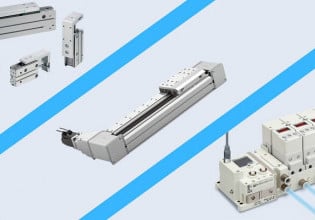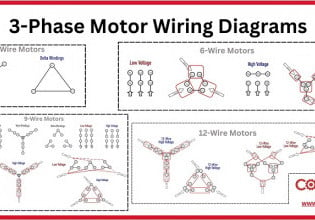Technology Highlights from ATX West 2023 - Magnetic Conveyance
Among the technologies demonstrated at the recent ATX West show in Anaheim, CA, were conveyor systems relying not on geared or belted tracks but rather on coil-driven magnets, providing control and feedback.
The concept of driving motion by energizing a magnetic field with a coil is nothing new. In fact, this fundamental concept provides the driving force for every electric motor, relay, and actuator in existence. However, the traditional method of moving objects is to link a motor with a movable belt surface, creating the universal ‘conveyor belt,’ visible in many processes.
Several of the technologies demonstrated at the recent Automation Technology Expo (ATX) West in Anaheim, CA, illustrated a less common but still widely respected form of motion control where the coils directly interface with the moving object rather than relying on a belt or track.

Magnetic conveyance was among many of the technologies demonstrated at ATX West 2023.
How Does a Magnetic Conveyor Work?
Under the surface of the motion platform is an array of small coils pointed at the target object. To move the target object along an axis, the array of electromagnets is polarized, much like a stepper motor, phase-by-phase, in order to drive the platform or carriage in a particular direction. The carriage (often called ‘pallet’) is equipped with powerful permanent magnets that follow the control of the energized coils.
Due to the finite control of the electromagnet array, the pallets can ride fractionally above the surface, nearly eliminating friction. They can often be rotated and tilted, which means six axes of control are possible, although many systems are designed only for motion in one linear axis, like a conveyor belt.
Are Magnetic Conveyors Better for Control?
For most of these applications, the benefit over traditional conveyance is realized in a few ways:
-
Reducing the number of moving components (gear, belt, chain transmissions) reduces losses in efficiency. Additionally, even in a modular conveyor, a portion of the track in motion does not have an object directly riding on it, adding to the inefficiency.
-
Feedback is possible directly from the drive coils by measuring the change in flux as the device passes over the coils, similar in concept to an inductive metal sensor. This eliminates the need for encoders, a massive benefit when the motion happens in more than one axis.
-
Multiple carriages or pallets can be controlled simultaneously, and with proper ID (like RFID), the exact location of each can be tracked and coordinated. In many cases, an engineer can remove one carriage for maintenance, and the rest of the system immediately recognizes and adjusts to the change.
No new technology is immediately a universal replacement for a predecessor for all cases, and this concept is no different. The conveying is useful in many medical and pharmaceutical applications and electronics and semiconductor manufacturing, provided the devices are not exposed to harmful effects from the electromagnetic coils.
SuperTrak CONVEYANCE
SuperTrak CONVEYANCE has designed a conveyor system that uses collaborative robotic and vision technology, coining the assembly "collaborative conveyance." With collaborative conveyance, an engineer can step into the line of conveyor pallets, and the system will adjust to a safe speed. If the human operator interferes with the system, such as reaching out a hand to stop the conveyor, it will respond accordingly.

SuperTrak’s “collaborative conveyance” uses collaborative robotic and vision technology to adjust to a safe speed when interacted with by a human operator.
This collaborative concept allows full interaction with the flexible system for fine-tuning, maintenance, and upgrades to ensure that rapid updates are possible.
Beckhoff Automation
Beckhoff, a company known for motion control and IPC technology, also demonstrated magnetic conveyance at ATX West with the XPlanar planar motor system. Although XPlanar may still be considered a conveyor, the motion is in multiple dimensions along a flat plane.

Beckhoff’s XPlanar planar motor system moves pallets around on a magnetic surface.
With precise control algorithms, pallets can be tilted to load/unload products, eliminating the need for human or robotic pickers alongside the system. Although the permanent magnets are indeed powerful, the engineering of the design directs the magnetic force down at the surface, and very little magnetic effect is felt on the upward-facing surface. This reduces the harmful EMI spread to nearby devices or products on the pallet.
Zaber Technologies
As the application scale moves down to precise linear stages, magnetic drives must be capable of exceptional repeatability and accuracy. Additionally, the feedback must be equally precise to enable drive resolution on the sub-micron level.

Zaber Technologies linear axes include traditional ball/lead screw drive and magnetic track linear drive technology.
Zaber Technologies showcased a variety of linear axes, not only in the traditional ball/lead screw drive but also in the astounding precision possible with the magnetic track linear drive, highlighted in the LDM and LDA series in the above image. With incremental moves of 20 nm and an encoder resolution of 1 nm, linear stages are perfect for automatic microscopy and fine feature control.
Magnetic Drives
Magnetic drive technology capitalizes on one of the oldest electronic concepts to eliminate many of the challenges placed on conventional conveyance systems. As long as these devices are efficient, effective, and easily controlled, they are certain to find use in several key application areas.






